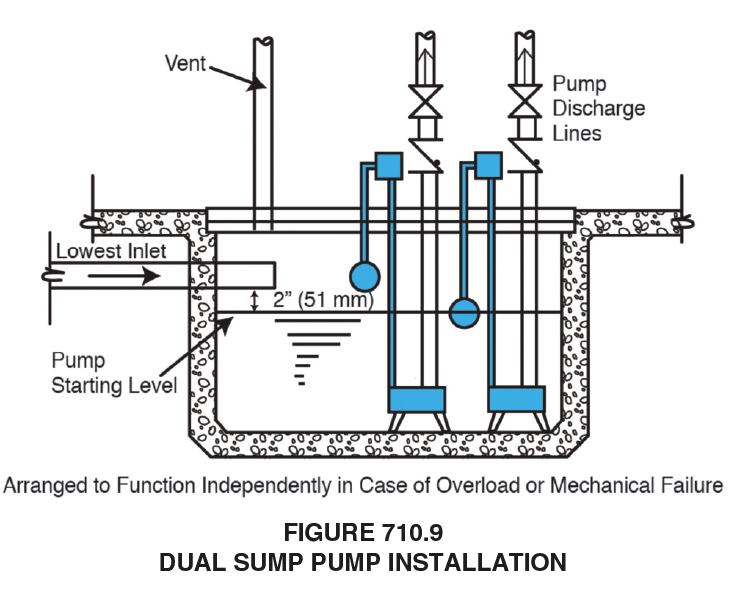April 6, 2023

If you have questions or comments, join the discussion on our LinkedIn forum.
From the 2021 UPC Illustrated Training Manual, Chapter Chapter 7, SANITARY DRAINAGE
710.8 Sump and Receiving Tank Construction. Sumps and receiving tanks shall be watertight and shall be constructed of concrete, metal, or other approved materials. Where constructed of poured concrete, the walls and bottom shall be adequately reinforced and designed to recognized acceptable standards. Metal sumps or tanks shall be of such thickness as to serve their intended purpose and shall be treated internally and externally to resist corrosion.
710.9 Alarm. Such sumps and receiving tanks shall be automatically discharged and, wherein a “public use” occupancy, shall be provided with dual pumps or ejectors arranged to function alternately in normal use and independently in case of overload or mechanical failure. The pumps shall have an audio and visual alarm, readily accessible, that signals pump failure or an overload condition. The lowest inlet shall have a clearance of not less than 2 inches (51 mm) from the high-water or “starting” level of the sump.
There is a basic purpose for providing dual pumps in public-use occupancies. It is essential for public health reasons that waste removal systems always function and that the building is never deemed to have become “insanitary” due to lack of waste removal. This condition would legally require the building to be taken out of service. Obviously, it is essential that failure of either pump be made evident through a fail-proof alarm system so that timely repairs may be made and the building kept in service.
In this dual-pump installation it is necessary that a “cycling” switch be included as a basic element of these installations so that each pump is regularly activated on every other cycle. Every time pumping action is called for, the pump that was not active on the previous cycle will now become the active pump. The objective in having alternative cycle are:
1. To exercise each pump as a test to confirm that both pumps are operational, and
2. To work both pumps by having them on for approximately equal periods of time.
An inactive pump, as an emergency standby pump, will often become useless over a period of time simply because of the deleterious effect water will have on a submerged dormant pump. The second pump in a dual-pump system is required by code, not because it is considered to be an “emergency” pump, but rather, to prevent an emergency condition. It is required as an operational pump that is intended to share the load equally with its counterpart (see Figure 710.9).

In addition to switching pumps alternately, there must be an alarm system installed (both visual and audio) to provide notification when either of these pumps fails to activate. The cycling switch will sense pump failure and will cycle back to the pump that was last active, ensuring that waste discharge will always occur.
The 2021 Uniform Plumbing Code Illustrated Training Manual is available for purchase here.
(This is not to be considered the official position of IAPMO, nor is it an official interpretation of the Codes.)
Last modified: April 6, 2023
